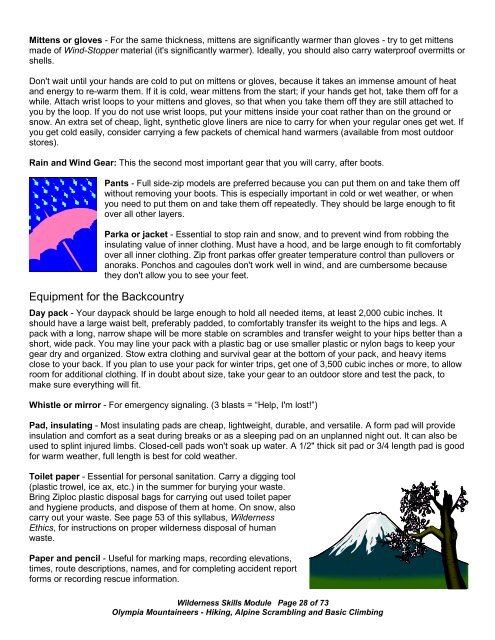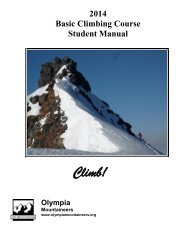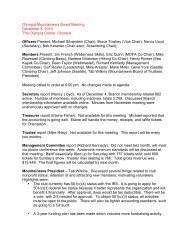Wilderness Skills - Olympia Mountaineers
Wilderness Skills - Olympia Mountaineers
Wilderness Skills - Olympia Mountaineers
Create successful ePaper yourself
Turn your PDF publications into a flip-book with our unique Google optimized e-Paper software.
Mittens or gloves - For the same thickness, mittens are significantly warmer than gloves - try to get mittens<br />
made of Wind-Stopper material (it's significantly warmer). Ideally, you should also carry waterproof overmitts or<br />
shells.<br />
Don't wait until your hands are cold to put on mittens or gloves, because it takes an immense amount of heat<br />
and energy to re-warm them. If it is cold, wear mittens from the start; if your hands get hot, take them off for a<br />
while. Attach wrist loops to your mittens and gloves, so that when you take them off they are still attached to<br />
you by the loop. If you do not use wrist loops, put your mittens inside your coat rather than on the ground or<br />
snow. An extra set of cheap, light, synthetic glove liners are nice to carry for when your regular ones get wet. If<br />
you get cold easily, consider carrying a few packets of chemical hand warmers (available from most outdoor<br />
stores).<br />
Rain and Wind Gear: This the second most important gear that you will carry, after boots.<br />
Pants - Full side-zip models are preferred because you can put them on and take them off<br />
without removing your boots. This is especially important in cold or wet weather, or when<br />
you need to put them on and take them off repeatedly. They should be large enough to fit<br />
over all other layers.<br />
Parka or jacket - Essential to stop rain and snow, and to prevent wind from robbing the<br />
insulating value of inner clothing. Must have a hood, and be large enough to fit comfortably<br />
over all inner clothing. Zip front parkas offer greater temperature control than pullovers or<br />
anoraks. Ponchos and cagoules don't work well in wind, and are cumbersome because<br />
they don't allow you to see your feet.<br />
Equipment for the Backcountry<br />
Day pack - Your daypack should be large enough to hold all needed items, at least 2,000 cubic inches. It<br />
should have a large waist belt, preferably padded, to comfortably transfer its weight to the hips and legs. A<br />
pack with a long, narrow shape will be more stable on scrambles and transfer weight to your hips better than a<br />
short, wide pack. You may line your pack with a plastic bag or use smaller plastic or nylon bags to keep your<br />
gear dry and organized. Stow extra clothing and survival gear at the bottom of your pack, and heavy items<br />
close to your back. If you plan to use your pack for winter trips, get one of 3,500 cubic inches or more, to allow<br />
room for additional clothing. If in doubt about size, take your gear to an outdoor store and test the pack, to<br />
make sure everything will fit.<br />
Whistle or mirror - For emergency signaling. (3 blasts = “Help, I'm lost!”)<br />
Pad, insulating - Most insulating pads are cheap, lightweight, durable, and versatile. A form pad will provide<br />
insulation and comfort as a seat during breaks or as a sleeping pad on an unplanned night out. It can also be<br />
used to splint injured limbs. Closed-cell pads won't soak up water. A 1/2" thick sit pad or 3/4 length pad is good<br />
for warm weather, full length is best for cold weather.<br />
Toilet paper - Essential for personal sanitation. Carry a digging tool<br />
(plastic trowel, ice ax, etc.) in the summer for burying your waste.<br />
Bring Ziploc plastic disposal bags for carrying out used toilet paper<br />
and hygiene products, and dispose of them at home. On snow, also<br />
carry out your waste. See page 53 of this syllabus, <strong>Wilderness</strong><br />
Ethics, for instructions on proper wilderness disposal of human<br />
waste.<br />
Paper and pencil - Useful for marking maps, recording elevations,<br />
times, route descriptions, names, and for completing accident report<br />
forms or recording rescue information.<br />
<strong>Wilderness</strong> <strong>Skills</strong> Module Page 28 of 73<br />
<strong>Olympia</strong> <strong>Mountaineers</strong> - Hiking, Alpine Scrambling and Basic Climbing




